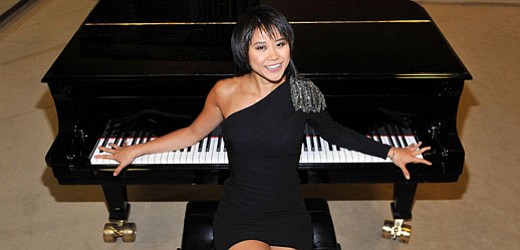 Facebook
Facebook
 X
X
 Instagram
Instagram
 TikTok
TikTok
 Youtube
Youtube

In this day and age of computer-generated sounds and images, as the precious bud of virtual reality starts to blossom upon our consciousness, it’s nice to be reminded that technique often trumps technology. On Saturday night, we got that reminder as Yuja Wang and the San Diego Symphony did their entire concert without any CGI or sound effects.
The concerts on Friday and Sunday had Ms. Wang playing Mozart but on Saturday night it was Tchaikovsky’s Piano Concerto No. 2. The technique for which Wang is world famous was out for all to hear and see.
The last time Tchaikovsky’s second was performed by the Symphony the soloist was Garrick Ohlsson. I’m not about to compare the styles of different pianists but I will say that hearing Wang play the Tchaikovsky was a different experience than hearing Ohlsson play it. I understand how sensitive these types of comments can be so I’m couching it as well as I can. Neither was better but both were superior in their own unique way.
On Saturday night, Wang’s performance came off as super-human. If, theoretically, Tony Stark were to produce an Iron Man suit that played the piano, it would be based on Yuja Wang. The technology would have to be based on her technique. However, the performance was not all super feats of pianistic heroism.
The second movement is something of a contemplative triple concerto with the piano, violin and cello. Concertmaster Jeff Thayer handled the violin and principal cellist Yao Zhao provided the cello. The communication between the three soloists and the orchestra created some magnificent and tender moments.
The final movement was the auditory equivalent of the visual highlights of an Avengers movie — I’m sticking with this Comic Con vibe for now. The feeling of being overwhelmed by an unstoppable force might be the only way to describe it.
Rimsky-Korsakov’s Capriccio espagnol could almost be entitled Rimsky-Korsakov’s Guide to the Orchestra. Each section of the orchestra was featured almost as if it were a didactic piece of music. It is not an educational treatise but each section of the orchestra has a prominent part to play.
The distinction of the instrumentation plays well in a live performance. The sound is coming from a spot on the stage and the audience can hear the music being passed from one area to another. This is something recordings cannot recreate — yet.
And so we return to our opening thought. Rimsky-Korsakov's technique as an orchestration expert, coupled with that of the orchestra, offers a better experience than that of any technology.


In this day and age of computer-generated sounds and images, as the precious bud of virtual reality starts to blossom upon our consciousness, it’s nice to be reminded that technique often trumps technology. On Saturday night, we got that reminder as Yuja Wang and the San Diego Symphony did their entire concert without any CGI or sound effects.
The concerts on Friday and Sunday had Ms. Wang playing Mozart but on Saturday night it was Tchaikovsky’s Piano Concerto No. 2. The technique for which Wang is world famous was out for all to hear and see.
The last time Tchaikovsky’s second was performed by the Symphony the soloist was Garrick Ohlsson. I’m not about to compare the styles of different pianists but I will say that hearing Wang play the Tchaikovsky was a different experience than hearing Ohlsson play it. I understand how sensitive these types of comments can be so I’m couching it as well as I can. Neither was better but both were superior in their own unique way.
On Saturday night, Wang’s performance came off as super-human. If, theoretically, Tony Stark were to produce an Iron Man suit that played the piano, it would be based on Yuja Wang. The technology would have to be based on her technique. However, the performance was not all super feats of pianistic heroism.
The second movement is something of a contemplative triple concerto with the piano, violin and cello. Concertmaster Jeff Thayer handled the violin and principal cellist Yao Zhao provided the cello. The communication between the three soloists and the orchestra created some magnificent and tender moments.
The final movement was the auditory equivalent of the visual highlights of an Avengers movie — I’m sticking with this Comic Con vibe for now. The feeling of being overwhelmed by an unstoppable force might be the only way to describe it.
Rimsky-Korsakov’s Capriccio espagnol could almost be entitled Rimsky-Korsakov’s Guide to the Orchestra. Each section of the orchestra was featured almost as if it were a didactic piece of music. It is not an educational treatise but each section of the orchestra has a prominent part to play.
The distinction of the instrumentation plays well in a live performance. The sound is coming from a spot on the stage and the audience can hear the music being passed from one area to another. This is something recordings cannot recreate — yet.
And so we return to our opening thought. Rimsky-Korsakov's technique as an orchestration expert, coupled with that of the orchestra, offers a better experience than that of any technology.
Comments